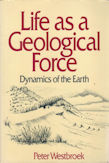His story begins in Java, where the ocean’s crust is plunging into the earth, creating both the island and enormous earthquakes and volcanoes. Near Java is the Java trench, 12,000 feet of water beneath which lies 15,000 feet of sediment. The tale then moves on to a lush green valley of Scotland, once part of North America, whose limestone cliffs are composed of shelly organisms, most of them extinct. Both Java and Scotland, and many other parts of the world, were formed by the same process, the movement of tectonic plates.
This is the world of the large, which cannot be understood apart from the world of the small: for example, bacteria that capture carbon dioxide and nitrogen from the air and convert them into organic matter, helping Holland to hold back the sea; or the miraculous Emiliania, a single-celled alga, one-hundredth of a millimeter in diameter. This plankton floats freely in the upper layers of the open ocean where it collects solar radiation for its energy, helps form clouds, and reproduces every day, forming giant blooms spanning the oceans,
Engaging our imagination about how forms of life work, these and other examples entertain as they inform. To nurture the earth we must understand it: this is the long task in which Peter Westbroek invites us to join.
